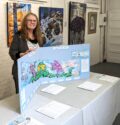Letters
Turtle nesting season inches closer
May 4, 2021
To the Editor,
False starts to spring are certainly not uncommon but this year really has been a tease.
We were present when a clutch of last falls painted turtle hatchlings that overwintered emerged from their nest on April 9. This is the earliest arrival we have witnessed! A couple weeks after that the cooler temperatures moved back in and since then there has been the odd turtle sighting reported but mostly turtle activity on the roads has been sparse.
Weather broadcasters and meteorologists are predicting that May will be a cool and rainy month. Typically turtles start nesting mid May and this goes through to mid July. The month of June is the peak period for nesting.
The cooler temperatures predicted for May could prompt more turtles to instead nest in June. Turtles however have a biological timeline to meet so some turtles will be seeking those
optimal ‘windows of time’ when the temperatures are not too cool or too hot to travel (16°C to 26°C range) so they can get to the business of nesting. The males will be on the move as well.
Don’t be caught off guard, turtles finding those optimal windows of time could start to nest as soon as mid May. Moving forward expect to see turtles on or near the roads or ATV trails if you are driving, as well as on lawns, in parks, on driveways, in gardens, public spaces, etc!
Turtles nesting
During nesting season increased nesting activity accompanied by road crossings are more apt to occur…
- In the early mornings through to about noon. Turtles are less likely to be on the move during the afternoon if it is hot and sunny but exceptions are always possible.
- In the evenings as the hot afternoon temperatures begin to come down. Nesting turtles are known to sometimes use the milder evening/night temperatures and protective cover of darkness to lay their eggs.
(3) During light intermittent showers and/or after it rains ‘regardless of the time of day’ nesting activity will often increase.
Although the rain is more inclined to encourage us indoors this is not the case for the turtles during nesting season. Rainy and humid days should put drivers on high turtle alert!
There are several reasons turtle nesting behavior aligns with the rain. These include; (a) turtles are highly aquatic and increased moisture simulates an environment they are most akin to, (b) turtles feel they can move from point A to B and not dry out, (c) the ground is softer and easier to dig a nest to lay eggs, and (d) rain will help erase most of the visual clues from nesting and (e) help dissipate the scent that lingers after a female has nested. All strong indicators that turtles are very much in tune with their environment and although they do not remain with the nest as do other animal species they do make choices that give the nest the best possible chance of surviving.
(4) This year’s “Strawberry Moon” is June 24.
The full moon has not been scientifically proven to influence freshwater turtle species nesting habits nor has it been disproven. Given the affect moon phases have on water it is not a far stretch to think that aquatic life would fall under the cascading affects of the full moon in some way.
In Native American teachings, the 13 scutes and the 28 plates on a turtle’s back hold the key to the 13 lunar months with 28 days each and the changing seasons.
The connections turtles have with the Strawberry Moon during nesting season are very obvious each year.
On a mission
Female turtles have a strong nesting site fidelity that most often has ancestral connections. Once a female has found a good nesting site, she often remains faithful to it throughout her life. This could potentially mean there are nesting sites where the mother turtle and possibly at least one of her offspring having reached sexual maturity may be nesting at the same nesting grounds every year.
Some nesting grounds require females turtles to travel great distances to dig a nest and lay eggs. When we sometimes spot turtles crossing roads in a direction that takes them away from obvious turtle habitat and we think this odd, it might just be to do with nesting as such that is a turtle on a mission. If helping a turtle across the road always move the turtle in the direction the turtle was headed.
Injured turtles
If you encounter an injured turtle please call the Ontario Turtle Conservation Centre home to Ontario’s turtle hospital at 705-741-5000. The OTCC will provide medical care at no charge and have turtle taxi volunteers to assist with transportation from anywhere in Ontario.
Should you have any turtle related questions or concerns please contact Think Turtle Conservation Initative. Thank you for helping the turtles and by doing so protecting the wildlife they live alongside, the ecosystems they work together to support that ensure the ecosystem services we depend on and benefit from. Protecting any one species protects us all!
If driving please be mindful of the turtles and other wildlife we share the roads with.
Have a good day! Take care and stay safe.
Kindest regards,
Kelly Wallace, managing director
Think Turtle Conservation Initiative

















